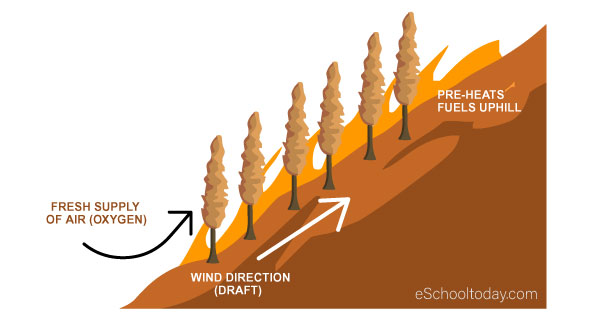- Wildfires
Factors that make wildfires burn more.
Some factors combine to provide a complex web of ingredients that help wildfires to burn more and quicker. Here are a few:
Wind
Winds direct or change the direction of fire to new areas with new fuels. Additionally, they provide a fresh supply of oxygen, a key ingredient of fire, to the situation.
Slope
 Wildfires usually move faster uphill than downhill. The steeper the slope, the faster they burn. It is because steeper slopes tend to have lots of fuels close, and the wind action is much more aggressive uphill.
Wildfires usually move faster uphill than downhill. The steeper the slope, the faster they burn. It is because steeper slopes tend to have lots of fuels close, and the wind action is much more aggressive uphill.
Temperature
Conditions with higher temperatures tend to absorb moisture from fuels and make them conducive to catch fire. It is why areas with lots of sun and higher temperatures tend to be dry and has more fire events.
Humidity
Fuels in locations with high humidity and rainfall tend to be damp and moist. Humidity is the amount of water vapor in the air. The higher the humidity, the higher the moisture in the fuels there, and the less likely they are to catch fire.
Times and seasons
In many places, the seasons tell a story. In the US, the summer stretch registers lots of fires. That is because the summer heat makes fuels drier and provides richer oxygen than the winter seasons. In many places in West Africa, the onset of the dry Harmattan winds from the Sahara desert in the dry seasons make fires burn more.
Fuels
The ease at which wildfires spread also depends on the fuel composition. Trees and vegetation with lots of moisture tend to slow down fires than dry vegetation such as dry grass, dead leaves, tree needles, brush, and small trees. Additionally, some vegetation with high oils and resins aid combustion and makes fires burn with more ease.
Space between fuels
Wildfires burn more and spread faster if there are more fuels close. If fuels are sparsely distributed or are patchy, the fires tend to slow down. A method of ending a fire with this concept is to create a ring of space around it.
